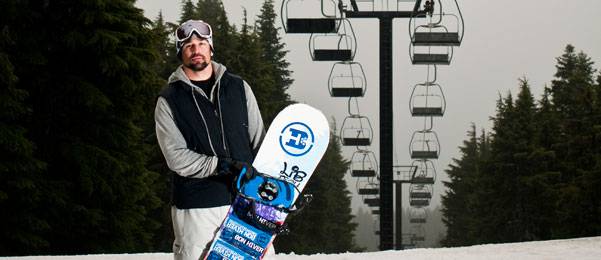Shredding Convention
T’07 Brendan Walker’s new high-tech Freebase binding system could change the way snowboarders hit the slopes.

Carving wide, graceful turns down a steep mountain is one of the joys of snowboarding. But the end of each run brings a decidedly different experience. Without the aid of ski poles, riders often must sit down and painstakingly disengage their rear binding before skating to the lift. Although most learn to live with it, Brendan Walker T’07 didn’t. An avid snowboarder, he set out to build a better binding and is now the founder and CEO of Bon Hiver. The company makes the Freebase binding, which allows snowboarders to quickly lock and unlock boot and binding together with a simple twist of the foot.
With Walker’s system, which has rare-earth magnets embedded in the binding and board plate, riders only have to fasten their bindings once during an entire day. It’s a solution as intuitive as past snow-sports innovations like parabolic skis and telescoping ski poles. And while bringing this product to market hasn’t been easy, Walker admits it would not have been possible without his Tuck education, which gave him the support and guidance to launch his venture far more quickly—and sensibly—than he could have done on his own.
“Getting an MBA doesn’t make someone an entrepreneur,” says Walker, “just like giving someone a compass doesn’t make them an explorer. But for those who possess an entrepreneurial spirit, a place like Tuck can take you much further, much faster. If I had looked to start this company myself and spent the first three months just learning accounting, I might have gone out of my mind. There would have been so many things out of my reach.”
Walker has been a snowboarder for 20 years. He grew up in the Hudson River valley and spent his winters riding at Vernon Valley/Great Gorge, a ski area 40 minutes outside New York City in New Jersey. He says snowboard binding systems have changed very little since the 1980s, with manufacturers sticking with a tried-and-true set up: a step-in binding with a base plate, toe strap, ankle strap, and high-back base. Over the years, people have tried to come up with different technologies, but Walker says most made the critical mistake of attempting to adapt vertical-compression technology used in ski bindings. “It’s naturally much cheaper to adapt an existing technology than to develop something completely new,” he explains, “but making an investment in new technology can also have some significant financial benefits.”
Walker created his first proof-of-concept for Freebase with foam poster board while at UBS, where he worked in fixed-income derivatives immediately after Tuck. The experience gave him an appreciation for the price volatility of the rare-earth magnets called neodymiums, which he uses in his binding system and which can be found in everything from the Toyota Prius to computer hard drives. “In one year, their price went up about four times what it was previously,” he notes.
Soon he was finding his way around three-dimensional design programs like Google SketchUp and putting his electrical engineering degree from West Point to good use, researching the technology that would make his idea a reality. At Tuck, through courses such as the Technology Strategy elective,Walker learned the importance of protecting intellectual property and how difficult it is to take a chance on a new design. He anxiously recalled the words of one of his professors, who warned students that “90 percent of ideas die when they reach the patent office.” When he discovered that no similar technology existed, he became even more nervous, wondering if there was some flaw in his thinking. “At first, I was relieved,” he recalls. “Then I was scared.”
Walker filed his patent in 2009 and secured funding from a fellow snowboarder who also happened to be a former oil trader. “As soon as I told him about the idea, he asked me if I needed any money,” recalls Walker. He officially launched Bon Hiver in early 2010 and entered the product-development phase soon after. By November of that year, he was testing a prototype on the mountain. The challenges for Walker continued when it came time to find a manufacturer.
“It’s not like textiles,” he says. “This is a very niche product. There are only about five manufacturers in the world that make bindings, and they are all in China. If you want to start out by making a few thousand, they won’t even return your phone call.” After multiple trips to the country—which also happens to be the world’s leading producer of rare-earth materials—Walker found a manufacturer that suited his needs, one willing to start production with a somewhat smaller initial order than others in the industry would agree to.
On the consumer side, Walker recognized the importance of getting the branding right for this highly discerning market. “When it comes to bindings, you can’t tell one product from another,” he notes, “which may lead some to believe that branding takes a back seat.” But as a snowboarder himself, Walker is aware of how many major companies have attempted to sell to this market and failed. “If it doesn’t smell authentic, they won’t touch it,” he says. Walker addresses this by speaking the language of his consumers. The product description for Freebase adopts a casual but clever tone that replicates the snowboarding vernacular: “Strap-in, step-ins, hybrids—yeah, there are some solid binding systems on the market today. But like Evel Knievel on a bad day, they all just fall a bit short of the target.”
Looking ahead, Walker plans to further leverage this technology beyond the finite market of snowboarding, even as he continues to roll out his new product.“Bon Hiver isn’t…just a binding company,” he said in an interview with Transworld Business, a board-sports news magazine. “It’s a movement. It’s a revolution, and it represents dissatisfaction with the status quo.”